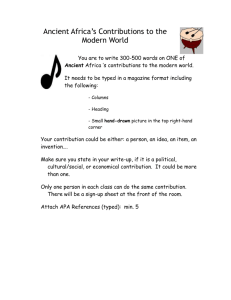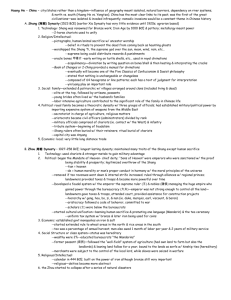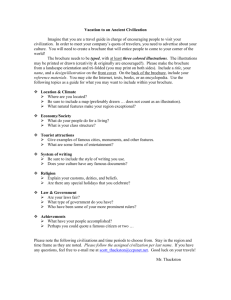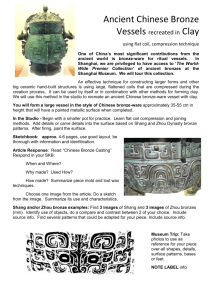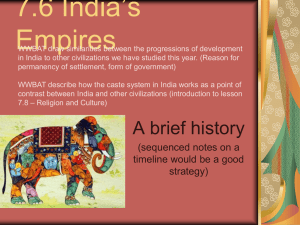Foundations of Indian Civilization (p.174)
advertisement
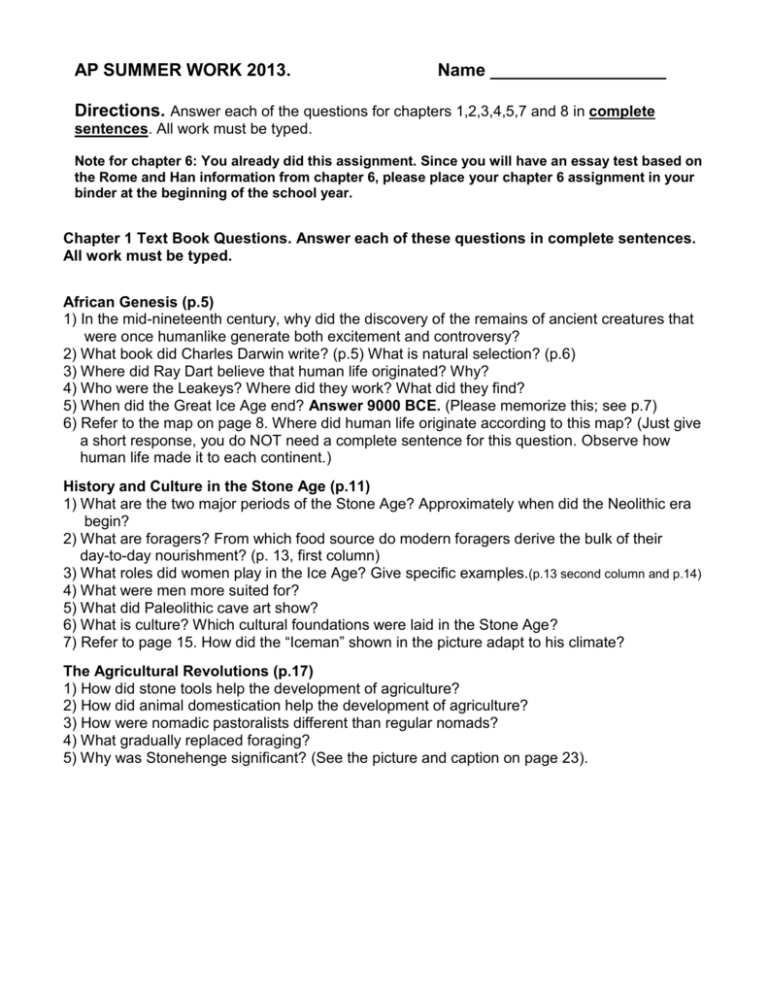
AP SUMMER WORK 2013. Name __________________ Directions. Answer each of the questions for chapters 1,2,3,4,5,7 and 8 in complete sentences. All work must be typed. Note for chapter 6: You already did this assignment. Since you will have an essay test based on the Rome and Han information from chapter 6, please place your chapter 6 assignment in your binder at the beginning of the school year. Chapter 1 Text Book Questions. Answer each of these questions in complete sentences. All work must be typed. African Genesis (p.5) 1) In the mid-nineteenth century, why did the discovery of the remains of ancient creatures that were once humanlike generate both excitement and controversy? 2) What book did Charles Darwin write? (p.5) What is natural selection? (p.6) 3) Where did Ray Dart believe that human life originated? Why? 4) Who were the Leakeys? Where did they work? What did they find? 5) When did the Great Ice Age end? Answer 9000 BCE. (Please memorize this; see p.7) 6) Refer to the map on page 8. Where did human life originate according to this map? (Just give a short response, you do NOT need a complete sentence for this question. Observe how human life made it to each continent.) History and Culture in the Stone Age (p.11) 1) What are the two major periods of the Stone Age? Approximately when did the Neolithic era begin? 2) What are foragers? From which food source do modern foragers derive the bulk of their day-to-day nourishment? (p. 13, first column) 3) What roles did women play in the Ice Age? Give specific examples.(p.13 second column and p.14) 4) What were men more suited for? 5) What did Paleolithic cave art show? 6) What is culture? Which cultural foundations were laid in the Stone Age? 7) Refer to page 15. How did the “Iceman” shown in the picture adapt to his climate? The Agricultural Revolutions (p.17) 1) How did stone tools help the development of agriculture? 2) How did animal domestication help the development of agriculture? 3) How were nomadic pastoralists different than regular nomads? 4) What gradually replaced foraging? 5) Why was Stonehenge significant? (See the picture and caption on page 23). Chapter 2 Text Book Questions. Mesopotamia (p.29) 1) What does Mesopotamia mean? Where is it located? Why was it important? (p.29) 2) Refer to map on page 30. State which rivers flowed through Mesopotamia? Which river is located in a valley in Pakistan? (See the caption under the picture). 3) What was the Epic of Gilgamesh? Why was it important? (p.34) 4) Who was Hammurabi? Explain the significance of his legal code. 5) Very important: What do anthropologists believe happened to women’s social standing in Mesopotamia? Give examples to support your answer.(p.35 last paragraph) during the Neolithic Revolution? 6) On which number was the Sumerian/Mesopotamian math system based? What impact did this have? (p.40) 7) Were the floods of the Tigris and Euphrates generally predictable? How did this affect their world view? Egypt (p.40) 1) Was the flooding of the Nile generally predictable? How did this affect the Egyptian world view? 2) Define pharoah. Define ma’at. 3) Technology: What was the function of pyramids? 4) What is a bureaucracy? What is its purpose? 5) Where was Nubia? (p.41) Which precious metal did it contain? 6) Egypt was heterogeneous. What does this mean? 7) Describe the role, status and privileges of Egyptian women. (p.45, second column, last paragraph) Indus Valley Civilization (p.48) 1) The Indus River is in South Asia. Find this on a map. In March and April, what feeds the Indus River’s sources? (p.48, top of column 2) 2) Which two ancient cities developed on the Indus? (p.48) Describe two key features of these cities. (p.49) 3) Why were Indus Valley cities abandoned after 1900 BCE? (p.51, second column) 4) What caused the demise of the Hakra River civilization? (p. 51) Chapter 3 Text Book Questions. Answer each of these questions in complete sentences. All work must be typed. Early China (p.55) 1) Give three specific examples of geographic isolation in China. (p.56) 2) Name two great river systems in China. (The Xi in the south is a third). (p.57) 3) What is loess? (p.58) 4) How were agricultural patterns in northern China different than those in the south? (p.58) 5) Which metal was developed in Shang China circa 2000 BCE? 6) List the technological innovations of Shang China. 7) What were oracle bones? How did shamans from Shang China use oracle bones? (p.60) 7) Which dynasty replaced the Shang? Which concept did they use to justify the overthrow of the Shang? (p.61) 8) Memorize this: The three Chinese philosophies that occurred emerged the Zhou period were Legalism, Daoism, and Confucianism. 10) What was legalism? (p.62) [This should be about two sentences.] 11) What are the key features of Confucianism? (Review the Five Relationships and their political and social impact). (p.63) [This should be about two sentences.] 12) What are the key points of Daoism? (p.63; explain Yin and Yang). [This should be about two sentences.] Nubia (p.69) 1) Where was Nubia? What was its central geographic feature? 2) Who were the Kush? What did they develop? The Aegean World (p.73) 1) Where is the Aegean Sea located? 2) What skills made long distance trade possible for the Minoans and Mycenaeans? (p. 76 second column) Conclusion (p.79) 1) Why was the acquisition of bronze weapons a priority for the elite classes? 2) How was bronze used? 3) What led to the fall of Late Bronze Age Civilizations? Note: You will have to know that the Bronze Age ended the Neolithic Era, and the Iron Age ended the Bronze Age. Chapter 4 questions. Answer each of these questions in a complete sentence. All work must be typed. First Civilizations of the Americas (p.86) 1) Refer to the map on page 88. Where were the Olmec located? Where were the Chavin Located? 2) Refer to the picture on page 89. Which civilization sculpted this giant stone head? Who does it represent? 3) Who were the Chavin? Why were they important? (p.89) Celtic Europe (p.91) 1) Refer to the map on page 91. Describe the spread of the Celtic people. Where were the early Celts located? Where did they spread to by 500 BCE? 300 BCE? 200 BCE? 2) Who were the Druids? What important roles did they play? (p.92) The Assyrian Empire (p.93) 1) Refer to the map on page 94. Describe the extent of the Assyrian Empire from the tenth century BCE to the seventh century BCE. 2) Define the term mass deportation. (p.95) Why did the Assyrians use mass deportation? Israel (p.99) 1) What is the Hebrew Bible? Describe it. (p.99) Note: Christians call this the Old Testament. 2) Why did the Israelites flee to Egypt? (see the top of page 100). 3) What was written on the tablets that Moses received? What did these writings prohibit? (p.100) 4) Define the term diaspora (p.102) Phoenicia and the Mediterranean (p.103) 1) Which writing system did the Phoenicians develop? Why was it an important advance As compared to cuneiform or hieroglyphics? (p.104) 2) Refer to the map on page 106. Where was Phoenicia located? What did Phoenicia begin to do in the ninth century BCE. 3) Where was Carthage located and why was it important? (p.106) Chapter 5 Text Book Questions. Answer each of these questions in a complete sentence. All work must be typed. Ancient Iran (p.114) 1) Locate the country of Iran. Which ancient civilization developed in this region? 2) How was Persian society stratified (divided)? (see page 117 column 2). 3) What were satraps? Why were they important? (p.118) 4) How was Zoroastrianism, the main Persian religion, similar to Christianity? (p.121, first column) The Rise of the Greeks (p.121) 1) Describe the topography of Greece. What political effect did this have? What economic effect did this have? 2) Which form of cultural diffusion was transferred from the Phoenicia to Greece? 3) What is a polis? Why did this become the dominant political structure in ancient Greece? 4) What does acropolis mean? What does agora mean? 5) Who could vote in ancient Greece? 6) Describe the main differences between Athens and Sparta. (p.129) 7) Who was Pericles? Why was he important? The Struggle of Persia and Greece (p.130) 1) When were the Persian Wars? Who did Persia attack? What was the main result? 2) When did the classical period of ancient Greece begin? 3) Why was Socrates important? (p.133) 4) Briefly describe the achievements of Plato. (p.133) 5) In this course, slavery is referred to as coercive labor. Describe the role and treatment of Greek slaves. (p.134) 6) Who fought in the Peloponnesian War? When? What was the result? (p.135) 7) What were the accomplishments of Alexander the Great? (p.136) 8) What is meant by the Hellenistic Age? Name the areas that became Hellenized. (p.137) Chapter 7 questions. Answer each of these questions in a complete sentence. All work must be typed. 1) 2) 3) 4) 5) 6) 7) 8) 9) Foundations of Indian Civilization (p.174) Describe India’s geographic setting. List important mountains and rivers. Define monsoons. What was the period from 1500BCE to 500BCE known as? What does Varna mean? What are the four main castes of Hinduism? Which group is outside of this hierarchy? Draw the hierarchy. Describe gender roles and status at this time. Who was Siddhartha Gautama? What class was he born into? How did this change? What religion did he start? What are its core beliefs? List them. Define nirvana. What are stupas? What are bodhisattvas? What are main gods of Hinduism? Imperial Expansion and Collapse (p.183) 1) 2) 3) 4) 5) 6) 7) When was the Mauryan empire? List its main achievements. Explain the achievements of Ashoka. When and why did the Mauyan Empire end? When did the Gupta Empire come to power? When did it fall? Describe the cultural growth under the Gupta. Describe the Gupta’s government. Explain the technological developments under the Gupta. What did scientists, astronomers and mathematicians develop? 8) What was sati? (p.187 ) 9) Describe the gender roles of higher status women. 10) Describe the Gupta trade routes. What served as a medium of exchange? (p.187) Southeast Asia (p.190) 1) What are the three geographical zones of Southeast Asia? 2) Describe the climate of Southeast Asia. 3) Define the term swidden agriculture. When did people in this region start practicing this method of farming? 4) Describe the impact of Hindu and Buddhist cultures on Southeast Asia. 5) Describe the monument at Borobodur which is shown on page 193. Conclusion (read pages 194-195 and answer these questions) 1) Which factors led to the spread of Indian culture? 2) Which advanced technologies did India possess? In which area did India make a profound contribution? Chapter 8 Text Book Questions. Answer each of these questions in a complete sentence. All work must be typed. The Silk Road (p.203) 1) Refer to the picture on page 205. Which animal did the Chinese breed to facilitate Silk Road travel? Why did caravans often travel in the winter? 2) Which manufactured goods was China best known for? (p. 205 last paragraph) 3) What was major impact of Silk Road trade? (p.206) 4) Which invention made riding easier? (p.206) The Indian Ocean (p.207) Note: IOMS means Indian Ocean Maritime System 1) What was the IOMS? Which lands did it embrace? 2) Contrast the differences between Mediterranean sailors and IOMS sailors. 3) Note: The summer monsoons travel northeast; the winter monsoons travel southwest. Based on this information, if you were a Arab sailor traveling to India, would you go in the summer or winter. (This requires only a one word answer ). Routes Across the Sahara (p.210) 1) By 1100 CE, what was transported over the trans-Saharan caravan routes? 2) What does Saharan cave art tell us about past civilizations in this region? What caused this to change. 3) Scholars believe that camels came to the Sahara from _____________. 4) What is the Sahel? (p.215) 5) Where was the kingdom of Ghana? Note: Ghana means War Chief. Ghana became powerful due to the fact that it traded gold for salt (from the north). Sub-Saharan Africa (p.216) 1) What is sub-Saharan Africa? What are steppes? Savannas? 2) What are Great traditions? 3) What are Small traditions? 4) Note: Africa has over 1000 languages. What factors have caused this? 5) When did the Sahara turn dry? What demographic impact did this have? 6) Who were the Bantu? Where were they from? Where did they migrate to? 7) Which metal did the Bantu smelt? Note new terms: push factor--when people migrate because they are forced from their land; pull factor--people migrate in search of products of conquest Spread of Ideas (p.219) 1) Where and how did Buddhism spread? Give at least two sentences. (top of p.220)
